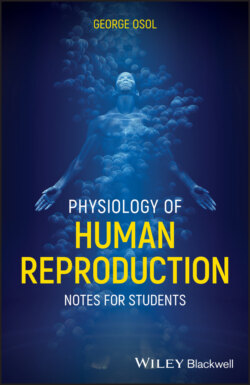Читать книгу Physiology of Human Reproduction - George Osol - Страница 6
ОглавлениеKey Concepts and Terms
Chapter 1: The Adult Male
1 1. Three basic requirements for male fertility
2 2. GnRH
3 3. LH and FSH
4 4. Pulsatile release
5 5. First vs. second messengers
6 6. Leydig cells
7 7. Action of LH
8 8. Testosterone
9 9. Sertoli cells
10 10. Three main types of sex steroids
11 11. Aromatization
12 12. Conversion of testosterone into estrogen
13 13. Action of FSH
14 14. Inhibin
15 15. Sertoli cell functions
16 16. The blood-testis barrier
17 17. Spatial relationships in males vs. females
18 18. Diverse actions of testosterone
19 19. Actions of testosterone in utero
20 20. Sexual differentiation
21 21. Androgens during puberty
22 22. DHT
23 23. 5α-reductase
24 24. Androgen insensitivity syndrome (AIS)
25 25. Sperm count
26 26. Seminiferous tubules
27 27. Spermatogonia
28 28. Primary spermatocytes
29 29. Secondary spermatocytes
30 30. Alignment of maternal and paternal chromosomes; genetic diversity
31 31. Spermatids
32 32. Acrosome
33 33. Axoneme
34 34. Spermiogenesis
35 35. Gymnosperm (X) vs. androsperm (Y)
36 36. Epididymal passage and decapacitation
37 37. Prostatic secretions
38 38. Secretions of the seminal vesicle
39 39. Clotting/de-clotting of semen
40 40. Process of liquefaction
41 41. Testicular thermoregulation
42 42. Cryptorchidism
43 43. Cremaster (mechanism 1)
44 44. Sweat glands (mechanism 2)
45 45. Countercurrent heat exchange (mechanism 3)
46 46. Pampiniform plexus
47 47. Varicocele
48 48. Asymmetry in vascular anatomy
49 49. Erectile tissue
50 50. Neurovascular mechanism of erection: parasympathetic + NO
51 51. cGMP is the intracellular second messenger in penile arteries
52 52. Filling phase
53 53. Tumescent phase
54 54. PDE-5 inhibitors
55 55. Ejaculatory reflex
56 56. Emission phase
57 57. Ejaculatory phase
58 58. Other muscular events during ejaculation
59 59. Male orgasm
60 60. Male infertility
61 61. Low sperm count
62 62. Semen analysis
63 63. WHO parameters for semen analysis
64 64. Hypospadias
65 65. Erectile dysfunction (ED)
66 66. Impotence vs. infertility
Chapter 2: The Nonpregnant Adult Female
1 67. Menarche
2 68. Menstrual cycle length
3 69. Hypothalamic pulse generator encoding
4 70. Mullerian and Wolffian ducts
5 71. Germinal epithelium
6 72. Oogonia
7 73. Primary oocytes
8 74. Process of attrition
9 75. Secondary oocyte
10 76. Arrest in metaphase
11 77. Ovum
12 78. Polar body
13 79. Granulosa cell precursors
14 80. Unilaminar or primordial follicle
15 81. Primary follicle
16 82. Follicular recruitment
17 83. Zona pellucida
18 84. Secondary follicle
19 85. Liquor folliculi
20 86. Tertiary (= dominant, vesicular, mature or Graafian) follicle
21 87. Follicular phase
22 88. Length of follicular vs. luteal phases
23 89. Estrogen
24 90. Cooperative mechanism between theca and granulosa cells
25 91. Thecal production of testosterone
26 92. Aromatization into estrogen by granulosa cells
27 93. Follicular cohort
28 94. Inhibin-activin family
29 95. Emergence of dominant follicle
30 96. Estrogen in the follicular phase
31 97. LH surge
32 98. Ovulatory phase
33 99. Ovulation detection kits
34 100. Cumulus oophorus
35 101. Corona radiata
36 102. Corpus luteum
37 103. Progesterone
38 104. Luteal phase
39 105. Endometrium
40 106. Menstrual phase
41 107. Proliferative phase
42 108. Secretory phase
43 109. Death of the corpus luteum
44 110. Rescue of the CL
45 111. Estrogen receptors: ERα and ERβ [111]
46 112. Major actions of estrogen
47 113. Major actions of progesterone
Chapter 3: Pregnancy, Parturition, Lactation
1 114. Secondary oocyte and its vestments
2 115. Corona radiata
3 116. Window of pregnancy
4 117. Number of viable sperm
5 118. Semen coagulation and liquefaction
6 119. Cervical mucus and sperm passage
7 120. Reverse peristalsis
8 121. Chemical losses/pregnancies
9 122. Capacitation
10 123. Decapacitation
11 124. Acrosome reaction
12 125. Cortical reaction
13 126. Zona reaction
14 127. Block to polyspermy
15 128. Species specificity
16 129. Cross-species fertilization
17 130. Zygote
18 131. Morula
19 132. Ectopic pregnancy
20 133. Blastocyst
21 134. Human chorionic gonadotropin (hCG)
22 135. Luteo-placental shift
23 136. Endometrial decidualization
24 137. Fraternal (dizygotic) twins
25 138. Identical (monozygotic twins)
26 139. Incidence of twinning
27 140. Spiral arteries
28 141. Structure of a fetal villus
29 142. Placental transport pathways
30 143. Gestational diabetes
31 144. Fetal circulation
32 145. Placental endocrine secretions
33 146. Pregnancy levels of estrogen and progesterone
34 147. Estrone (E1) and estriol (E3)
35 148. Nondisjunction
36 149. Turner syndrome (monosomies)
37 150. Klinefelter syndrome (trisomies)
38 151. Fetal membranes
39 152. Amniocentesis
40 153. Chorionic villous sampling (CVS)
41 154. Isolation of cell-free DNA
42 155. Earl pregnancy proteins
43 156. Cardiovascular adaptation
44 157. Respiratory adaptation
45 158. Uterine (myometrial) adaptation
46 159. Embryonic period
47 160. Fetal period
48 161. Progesterone block
49 162. Labor
50 163. Initiation of labor: fetus or mother?
51 164. Three stages of labor
52 165. Preterm delivery
53 166. Production and secretion of milk
54 167. Alveolar epithelial cells
55 168. Colostrum
56 169. Milk let-down reflex
57 170. Prolactin
58 171. Benefits of breastfeeding
59 172. Developmental origins of health and disease (DOHaD)
60 173. Long-term effects of pregnancy: consequence vs. predisposition?
Chapter 4: The Human Sexual Response
1 174. Masters and Johnson
2 175. Limbic system
3 176. Libido
4 177. Sexual arousal in the female
5 178. Sex flush
6 179. Orgasmic platform
7 180. G-spot
Chapter 5: Age-Related Changes in the Reproductive System
1 181. Puberty
2 182. Hypothalamic sensitivity in childhood
3 183. Molecular triggers that initiate puberty
4 184. Kisspeptin
5 185. Neurokinin B
6 186. Leptin
7 187. Process of puberty
8 188. Decline in male sexual function with age
9 189. Prostatic enlargement
10 190. Climacteric, menopause
11 191. Estrogen withdrawal
